© Copyright Atlanta Coin Expositions, 2008-2025. All Rights Reserved.
Several of the links on the pages within this web site go to affiliate vendors.
A vendor affiliation can mean a small monetary compensation to the web site owner at no additional cost to you.
Several of the links on the pages within this web site go to affiliate vendors.
A vendor affiliation can mean a small monetary compensation to the web site owner at no additional cost to you.
Coin Show
Information
Shop
General
Next Monthly Coin Show
Coin Show - Monthly Notes from December 2019
Engelhard Silver Bar
Ancient Roman Coin Constantine II 337-340 AD
The December 2019 Greater Atlanta Coin Show greeted many visitors to a somewhat holiday bourse where dealers and their displays showcased numismatic and other collectibles.
Thank you to the many people who visited the coin show to buy, sell, trade or just look at the many treasures, both historical and interesting.
Of course, we also appreciate the dealers, our security and the hotel's staff who support the coin show each month.
And, a big welcome and thank to several visiting dealers this month who filled in where a few regular dealers had schedule conflicts.
Thank you to the many people who visited the coin show to buy, sell, trade or just look at the many treasures, both historical and interesting.
Of course, we also appreciate the dealers, our security and the hotel's staff who support the coin show each month.
And, a big welcome and thank to several visiting dealers this month who filled in where a few regular dealers had schedule conflicts.
No "S" Dime 1983 Proof Set
Confederate States Belt Buckle
Ancient Roman Coin Domitian 81-96 AD
Ancient Roman Coin Gallienus 253-268 AD
Ancient Roman Coin Caracalla 198-218 AD
Depending on how you celebrate, we hope all of you have or had a happy, healthy and safe holiday season.
For the next coin show, first, it's Happy New Year.
The new 2020 bourse will be filled with displays of coins, currency, bullion, exonumia, scripophily, semi-precious stones, jewelry and other collectible items.
The dealers on the bourse offer a wide variety of displays and provide many years of knowledge and experience.
All are welcome whether buying, selling, trading or just looking at the many different items.
Mark your calendar and visit the next Greater Atlanta Coin Show on Sunday, January 12, 2020 in the Joe Mack Wilson ballroom to buy, sell, trade or just browse among the many items on display.
For the next coin show, first, it's Happy New Year.
The new 2020 bourse will be filled with displays of coins, currency, bullion, exonumia, scripophily, semi-precious stones, jewelry and other collectible items.
The dealers on the bourse offer a wide variety of displays and provide many years of knowledge and experience.
All are welcome whether buying, selling, trading or just looking at the many different items.
Mark your calendar and visit the next Greater Atlanta Coin Show on Sunday, January 12, 2020 in the Joe Mack Wilson ballroom to buy, sell, trade or just browse among the many items on display.
This December Sunday's weather provided a nice day with sunshine and temperatures in the mid-50s with some wind to stir the air every so often.
As for the hotel, they had a very lively and busy Saturday night prior to the show, but we did not see much activity in the rest of the conference space during our Sunday show.
We did learn that the hotel is beginning to start the improvements approved by the City of Marietta.
As for the hotel, they had a very lively and busy Saturday night prior to the show, but we did not see much activity in the rest of the conference space during our Sunday show.
We did learn that the hotel is beginning to start the improvements approved by the City of Marietta.
It will be interesting to watch the changes in the space over the next year.
On the bourse, the visitors made it a busy place to be.
Let's take a virtual tour of just a few of the items seen on the bourse.
On the bourse, the visitors made it a busy place to be.
Let's take a virtual tour of just a few of the items seen on the bourse.
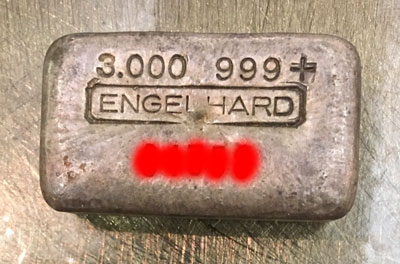
The precious metals industry has a number of companies who produce silver bars of all weights, sizes and designs. One as well known brand is Engelhard.
Many silver bars have intricate designs while others are simply silver. Engelhard placed more emphasis on the quantity and quality of their bars rather than offering fancy designs.
As a company, Engelhard no longer exists, however their silver bars are still traded today and are among the most sought after brands of silver bars in the industry.
Many silver bars have intricate designs while others are simply silver. Engelhard placed more emphasis on the quantity and quality of their bars rather than offering fancy designs.
As a company, Engelhard no longer exists, however their silver bars are still traded today and are among the most sought after brands of silver bars in the industry.
In the beginning, Charles Engelhard purchased the Charles F. Croselmire Company of Newark, New Jersey, in 1902. During the early 1900s the Engelhard company was the main fabricator of gold, silver, platinum in North America.
Throughout, Engelhard’s main business practices focused on precious metals, especially silver.
From his successes, Engelhard acquired other organizations during the remainder of the 20th century to expand their products in the precious metals industry.
But, things come to an end. The German company, BASF, purchased the Engelhard businesses in 2006.
Throughout, Engelhard’s main business practices focused on precious metals, especially silver.
From his successes, Engelhard acquired other organizations during the remainder of the 20th century to expand their products in the precious metals industry.
But, things come to an end. The German company, BASF, purchased the Engelhard businesses in 2006.
They dissolved the Engelhard name, however the quality of the earlier Engelhard silver remains popular and highly sought after today.
With the Engelhard focus on the value of the silver weight and purity, the bars have basic features of the Engelhard logo, weight, purity, and a serial number.
Knowing counterfeiting would be a problem, Engelhard placed a serial number on each bar that can be verified for authenticity.
This 3-ounce Engelhard may be simple in its design, but its value lies in its silver content and, to a certain degree, the Engelhard name stamped on the bar.
Besides, beauty is in the eyes of the beholder. To many, this is a beautiful silver bar.
With the Engelhard focus on the value of the silver weight and purity, the bars have basic features of the Engelhard logo, weight, purity, and a serial number.
Knowing counterfeiting would be a problem, Engelhard placed a serial number on each bar that can be verified for authenticity.
This 3-ounce Engelhard may be simple in its design, but its value lies in its silver content and, to a certain degree, the Engelhard name stamped on the bar.
Besides, beauty is in the eyes of the beholder. To many, this is a beautiful silver bar.
Our next specimen is a proof set without the "S" on the proof dime.
During three separate years, 1968, 1970 and 1983, the US Mint produced proof sets without "S" mint marks on the dime coins.
Per Jaime Hernandez of PCGS (Professional Coin Grading Service):
"The 1983 No S Proof Roosevelt Dime is the third and last No Proof S coin struck in the Proof Roosevelt Dime series. Most coins exist with Deep cameo surfaces since most Proof Dimes from the 1980s also had proof Deep Cameo surfaces.
During three separate years, 1968, 1970 and 1983, the US Mint produced proof sets without "S" mint marks on the dime coins.
Per Jaime Hernandez of PCGS (Professional Coin Grading Service):
"The 1983 No S Proof Roosevelt Dime is the third and last No Proof S coin struck in the Proof Roosevelt Dime series. Most coins exist with Deep cameo surfaces since most Proof Dimes from the 1980s also had proof Deep Cameo surfaces.

"The other two Proof No S Dimes are the 1968 and 1970 No S Dimes. The 1968 Proof No S is the scarcest from all three Proof No S coins. The 1970 and 1983 No S Proof Dimes compare in scarcity as there are several hundred examples in all grades combined believed to exist."
Of course, the no "S" proof dime was in error and quickly corrected, however, the quantity of the distributed errors is unknown.
Of course, the no "S" proof dime was in error and quickly corrected, however, the quantity of the distributed errors is unknown.
In 1983, the US Mint produced roughly 3.3 million proof sets. Currently, PCGS is showing a graded population of no "S" dimes at 451 while NGC (Numismatic Guaranty Corporation) has graded 182.
Some estimate the errors at the life of a proof die, which in 1983 was 3,000 to 3,500 coins.
Regardless of the quantity, this set includes a nice no "S" dime.
Some estimate the errors at the life of a proof die, which in 1983 was 3,000 to 3,500 coins.
Regardless of the quantity, this set includes a nice no "S" dime.
"Number of War Relics Are Found - George Burns Discovers Them in Old Stump at Sherman Reservation. Rooted Up By a Hog. Two Hundred and Twenty Coat Buttons and Fifteen Belt Buckles.
"Chickamauga Park Marshal George D. Barnes is the most lucky relic hunter who ever started a collection. Apparently he spied a hog rooting in a stump up on the Sherman reservation on the crest of the ridge above Sherman Heights. He went to drive the hogs from the government property and found that a belt buckle bearing the letters "C. S. A." had been unearthed. A little digging in the interior of the old stump soon unearthed the richest find of relics discovered for many years. Where he had finished picking them out and counting them, Mr. Barnes found he had fifteen belt buckles and 225 coat buttons that had at one time been the property of the Confederated States of America.
"Chickamauga Park Marshal George D. Barnes is the most lucky relic hunter who ever started a collection. Apparently he spied a hog rooting in a stump up on the Sherman reservation on the crest of the ridge above Sherman Heights. He went to drive the hogs from the government property and found that a belt buckle bearing the letters "C. S. A." had been unearthed. A little digging in the interior of the old stump soon unearthed the richest find of relics discovered for many years. Where he had finished picking them out and counting them, Mr. Barnes found he had fifteen belt buckles and 225 coat buttons that had at one time been the property of the Confederated States of America.
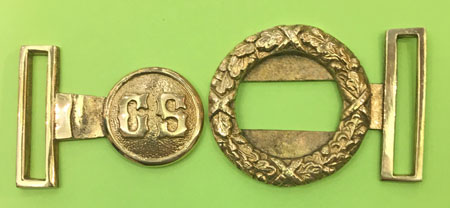
The next collectible is a reproduction spoon and wreath or tongue and wreath belt buckle from the Confederate States.
This type of belt buckle was worn by Confederate officers as the buckle for their sword or saber belt.
There are many versions of the spoon and wreath belt buckle.
Some include a plain wreath. Some have "FREEDOM OR DEATH" around the wreath while others are similar but different.
For the spoon, there are even more varieties, especially in the letters - smaller or larger, plain or decorated. There are also plain spoons and some with people engraved.
This type of belt buckle was worn by Confederate officers as the buckle for their sword or saber belt.
There are many versions of the spoon and wreath belt buckle.
Some include a plain wreath. Some have "FREEDOM OR DEATH" around the wreath while others are similar but different.
For the spoon, there are even more varieties, especially in the letters - smaller or larger, plain or decorated. There are also plain spoons and some with people engraved.
As for this example, it appears to be a reproduction of one of the buckles found in a hollow stump on Sherman's Heights, battlefield of Chattanooga, Tennessee, in 1909.
Civil War historians believe the Haiman & Bro. Manufacturing Co. out of Columbus, Georgia produced this particular buckle design.
A newspaper article from 1909 described the find:
Civil War historians believe the Haiman & Bro. Manufacturing Co. out of Columbus, Georgia produced this particular buckle design.
A newspaper article from 1909 described the find:
As for this spoon and wreath buckle, a reproduction of one of Mr. Barnes's relics, the original can be found in a Maryland-Steuart Collection.
"They had probably been in charge of some quartermaster's employee during hte battle of Mission Ridge and when the defeat came they were dropped into a hollow tree.
"Some months ago the tree was blown down and the stump rotted away. The hog did the rest.
"Mr. Barnes is the owner of the best collection of war relics in this section and is an enthusiastic relic hunter. He is, of course, much elated over this big find in the days when such things are growing scarce."
Today, Mr. Barnes would not be able to keep his find as there are laws protecting artifacts found at battle sites.
"Some months ago the tree was blown down and the stump rotted away. The hog did the rest.
"Mr. Barnes is the owner of the best collection of war relics in this section and is an enthusiastic relic hunter. He is, of course, much elated over this big find in the days when such things are growing scarce."
Today, Mr. Barnes would not be able to keep his find as there are laws protecting artifacts found at battle sites.
"He was also intensely concerned with the soundness of the economy and frequently revised tax laws to maximize the treasury's income and kept tax collectors busy round-the-clock. However, he did use these monies to rebuild Rome which had been through two major fires and the construction of many new building projects.
"For all the good he did, Domitian was still hated by the Senate which was kept on a short leash at all times. Suspicious of others by nature, anyone he suspected of plotting against him was summarily executed. Not much better fate befell any other government official suspected of embezzling funds or conducting otherwise corrupt dealings.
"For all the good he did, Domitian was still hated by the Senate which was kept on a short leash at all times. Suspicious of others by nature, anyone he suspected of plotting against him was summarily executed. Not much better fate befell any other government official suspected of embezzling funds or conducting otherwise corrupt dealings.
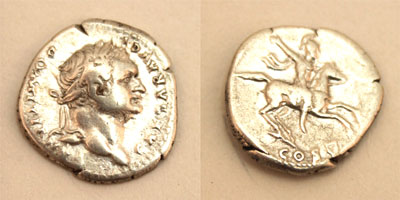
The next specimen comes from the ancient Roman coins, a Domitian.
From the Numiswiki at forumancientcoins.com:
"Domitian was one of Vespasian's sons and brother of Titus. Upon the death of Titus, Domitian was given the title of Augustus and thus became the emperor. Domitian campaigned extensively in Britain and present-day Germany, ultimately being successful in both areas.
From the Numiswiki at forumancientcoins.com:
"Domitian was one of Vespasian's sons and brother of Titus. Upon the death of Titus, Domitian was given the title of Augustus and thus became the emperor. Domitian campaigned extensively in Britain and present-day Germany, ultimately being successful in both areas.
"Another move which earned him enemies was the fact that he legislated strict moral laws while making no concessions in his own promiscuous affairs and other eccentric behaviors. Like so many other emperors, Domitian was assassinated in a plot that was left largely uninvestigated but that many scholars believe his successor, Nerva, played a role in.
"With a quarter century in power, the longest stay of any first century ruler, there are plenty of coins left of Domitian. From humble sub-As denominations to highly prized Aurei there is something available within the reach of any collector’s budget.
"While a Denarius is typically the most accessible coin, Domitian’s big copper is also well represented and, except for the very well preserved specimens, relatively affordable as well."
"With a quarter century in power, the longest stay of any first century ruler, there are plenty of coins left of Domitian. From humble sub-As denominations to highly prized Aurei there is something available within the reach of any collector’s budget.
"While a Denarius is typically the most accessible coin, Domitian’s big copper is also well represented and, except for the very well preserved specimens, relatively affordable as well."
This particular specimen shows his laureated head right, with CAESAR AVG F DOMITIANVS (Retrograde) around the obverse and on the reverse a helmeted horseman prancing right with COS V below.
Oh, the tales this coin could tell.
Oh, the tales this coin could tell.
Ancient Roman Coin Aelius 138 AD
"He is equally well represented in silver and copper. The Denarii naturally tend to hold up better than the various bronze denominations but due to scarcity neither is abundantly available in the top grades.
"Given the wide states of preservation for the bronzes it’s difficult to pin down a price range. Suffice to say that any which is well enough preserved to be attributable will be marketable."
"Given the wide states of preservation for the bronzes it’s difficult to pin down a price range. Suffice to say that any which is well enough preserved to be attributable will be marketable."

The next sample is another ancient Roman coin an Aelius.
From the Numiswiki at forumancientcoins.com:
"Hadrian appointed Aelius as his Caesar to succeed him but died of illness shortly before his own death. Aelius would probably have made a fine emperor as he was well liked by Roman citizens and was a capable military leader.
"Finding a coin of Aelius is a bit tricky. You’re not likely to just stumble onto one.
From the Numiswiki at forumancientcoins.com:
"Hadrian appointed Aelius as his Caesar to succeed him but died of illness shortly before his own death. Aelius would probably have made a fine emperor as he was well liked by Roman citizens and was a capable military leader.
"Finding a coin of Aelius is a bit tricky. You’re not likely to just stumble onto one.
This Aelius Denarius shows a bare-headed and draped bust facing right with L AELIVS CAESAR on the obverse. The reverse has Spes walking left, holding flower and raising hem of skirt with TR POT COS II around the design.
One wonders how long this coin circulated and how many collectors have enjoyed its history through the years.
One wonders how long this coin circulated and how many collectors have enjoyed its history through the years.
"When Constans had had enough and cut off communications with Constantine the elder reacted by bringing his army into Northern Italy. But Constans had anticipated these events and was well prepared to meet him. Caught off-guard by this counter-offensive, Constantine was killed in the fight and his possessions passed to Constans.
"Despite the relatively short reign as Augustus, the coins of this emperor are among the cheapest and easiest to locate… so long as you stick to the AE3’s. Coinage in other metals is reserved strictly for the big leagues.
"Despite the relatively short reign as Augustus, the coins of this emperor are among the cheapest and easiest to locate… so long as you stick to the AE3’s. Coinage in other metals is reserved strictly for the big leagues.
Another Roman coin, this one is for Constantine II.
From the Numiswiki at forumancientcoins.com:
"Constantine II was the oldest son of Constantine I and inherited all the Western portions of the empire except for Africa and Italy. Not content with this much he bullied his brother Constans and tried wresting these possessions away from him.
From the Numiswiki at forumancientcoins.com:
"Constantine II was the oldest son of Constantine I and inherited all the Western portions of the empire except for Africa and Italy. Not content with this much he bullied his brother Constans and tried wresting these possessions away from him.
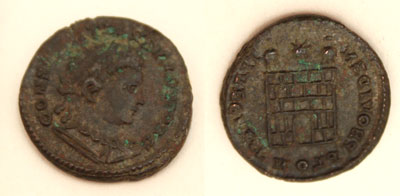
"Not surprisingly, the vast majority of the AE3’s will be of the young Constantine during his early years as Caesar and of these again the majority will be the ultra-common Gloria Exercitus types with either one or two standards. Those having the two standards will be the most common but the one-standard subtype is hardly a rarity.
"The so-called “camp gates” and votive issues are also very common. All of these may be found in collectible grades. Of course, the better the grade the higher the cost."
This Constantine II Roman coin shows a laureate bust facing right with CONSTANTINVS IVN NOB C on the obverse and a camp gate with two turrets and a star above and PROVIDENTIAE CAESS on the reverse.
This coin is one of the more common specimens and is not expensive, though it is very valuable historically.
"The so-called “camp gates” and votive issues are also very common. All of these may be found in collectible grades. Of course, the better the grade the higher the cost."
This Constantine II Roman coin shows a laureate bust facing right with CONSTANTINVS IVN NOB C on the obverse and a camp gate with two turrets and a star above and PROVIDENTIAE CAESS on the reverse.
This coin is one of the more common specimens and is not expensive, though it is very valuable historically.
This Roman coin represents Gallienus.
From the Numiswiki at forumancientcoins.com:
"The son of Valerian, Gallienus became emperor when his father was taken prisoner by a Persian King. His greatest contribution to military history was the first commissioning of a cavalry-only unit which could be dispatched anywhere within the empire within short order.
"He was also successful in repelling wave after wave of barbarian invaders as well as finally defeating Postumus after a prolonged period which saw the two in battlefields three times. Gallienus met a bloody end himself during the siege of another usurper, Aureolus, at the hands of his own soldiers.
From the Numiswiki at forumancientcoins.com:
"The son of Valerian, Gallienus became emperor when his father was taken prisoner by a Persian King. His greatest contribution to military history was the first commissioning of a cavalry-only unit which could be dispatched anywhere within the empire within short order.
"He was also successful in repelling wave after wave of barbarian invaders as well as finally defeating Postumus after a prolonged period which saw the two in battlefields three times. Gallienus met a bloody end himself during the siege of another usurper, Aureolus, at the hands of his own soldiers.
"Sometime during the reign of Gallienus, in an imperceptibly gradual process perhaps, Roman coins stopped being issued with anything resembling quality control. More regrettably, the use of currency as an art venue gave way to its most utilitarian uses.
"There was less care taken in the execution and craftsmanship of the dies, less variety of types and a generalized who-cares-what-they-look-like attitude that was pervasive from one corner of the empire to the next.
"Even the mighty Aureus had to suffer the indignity of wild swings in weights. Even the up-until-then sacrosanct purity of the gold itself dipped.
"There was less care taken in the execution and craftsmanship of the dies, less variety of types and a generalized who-cares-what-they-look-like attitude that was pervasive from one corner of the empire to the next.
"Even the mighty Aureus had to suffer the indignity of wild swings in weights. Even the up-until-then sacrosanct purity of the gold itself dipped.
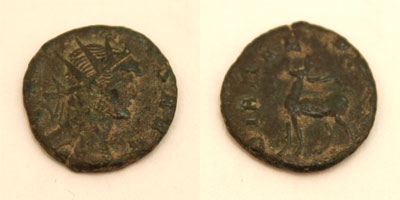
"But while the most drastic changes appear to have happened during the tenure of Gallienus there were still, thankfully, many exceptions to the rule. The Antoninianus was still being made in reasonably good metal during his first couple of years on the throne and one may actually find one today in good shape at a not-exorbitant cost.
"Just be aware that for every one of those there will be a cartful of deplorable coins available which, it must be remembered, were already unrecognizable before leaving the mint."
Based on this description, the detail found on this coin is somewhat remarkable.
The obverse contains GALLIENVS AVG with a radiate bust facing right on the obverse and DIANAE CONS AVG with an antelope walking left, right legs forward on the reverse.
At over 1750 years old and with poor mintage processes, it is amazing that the design on this coin is even comprehensible.
"Just be aware that for every one of those there will be a cartful of deplorable coins available which, it must be remembered, were already unrecognizable before leaving the mint."
Based on this description, the detail found on this coin is somewhat remarkable.
The obverse contains GALLIENVS AVG with a radiate bust facing right on the obverse and DIANAE CONS AVG with an antelope walking left, right legs forward on the reverse.
At over 1750 years old and with poor mintage processes, it is amazing that the design on this coin is even comprehensible.
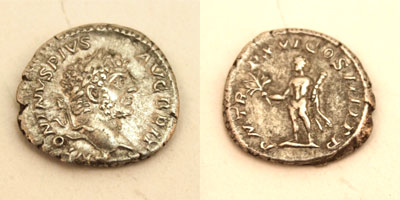
"Caracalla would go on to rule for another five years but his bad karma caught up with him and he was assassinated in a plot perpetrated by Macrinus.
"As an emperor Caracalla possessed few redeeming qualities and among the worst of them would be his ruinous drain on the treasury. Because he knew everyone hated him he sought the protection of the army.
"And the surest way of getting this protection was to buy it outright. He raised the pay of the solider to about four denarii per day, nearly quadrupling the salary of just a few years prior. And on top of their regular salary he heaped endless bonuses and other concessions meant to endear them.
"As an emperor Caracalla possessed few redeeming qualities and among the worst of them would be his ruinous drain on the treasury. Because he knew everyone hated him he sought the protection of the army.
"And the surest way of getting this protection was to buy it outright. He raised the pay of the solider to about four denarii per day, nearly quadrupling the salary of just a few years prior. And on top of their regular salary he heaped endless bonuses and other concessions meant to endear them.
Our last example for this month is another ancient Roman coin for Caracalla.
From the Numiswiki at forumancientcoins.com:
"Caracalla's real name was Marcus Aurelius Antoninus. He got the nickname from his habit of wearing a cloak by the same name.
"Caracalla was the elder son of Septimius Severus and brother of Geta whom he positively hated. Hated so much, in fact, that he had him murdered a few years later.
"In the mayhem that followed, Caracalla's men went on a killing spree of anyone suspected of being a Geta sympathizer. In the massacre, it's estimated up to 20,000 people lost their lives.
From the Numiswiki at forumancientcoins.com:
"Caracalla's real name was Marcus Aurelius Antoninus. He got the nickname from his habit of wearing a cloak by the same name.
"Caracalla was the elder son of Septimius Severus and brother of Geta whom he positively hated. Hated so much, in fact, that he had him murdered a few years later.
"In the mayhem that followed, Caracalla's men went on a killing spree of anyone suspected of being a Geta sympathizer. In the massacre, it's estimated up to 20,000 people lost their lives.
"This money could only have come by the oppressive taxation of ordinary citizens as well as the seizures of property of the wealthy under trumped-up charges. This not only intensified the hatred against him but also had the effect of corrupting the military who had become accustomed to this life of luxury and throwing the economy into lasting disarray.
"As is the case with the coins of his parents, Caracalla is also very well represented in the silver Denarius but pretty scarce in the copper denominations."
This coin has interesting designs.
The obverse contains ANTONINVS PIVS AVG BRIT with a laureate bust facing right.
"As is the case with the coins of his parents, Caracalla is also very well represented in the silver Denarius but pretty scarce in the copper denominations."
This coin has interesting designs.
The obverse contains ANTONINVS PIVS AVG BRIT with a laureate bust facing right.
The reverse shows P M TRP XVI COS IIII PP with a figure of Hercules standing facing left and holding a branch, a club and a lion's skin.
Today, this coin represents a ruler whose actions definitely failed economically and can provide lessons in what not to do.
Today, this coin represents a ruler whose actions definitely failed economically and can provide lessons in what not to do.
